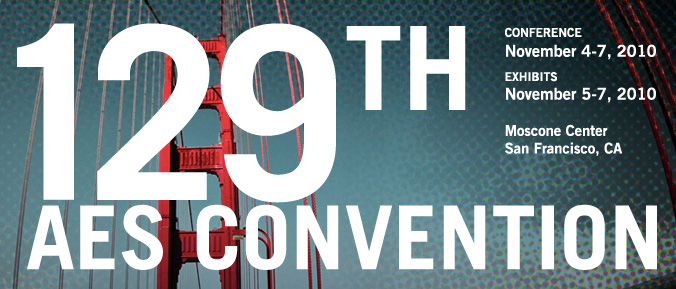
AES San Francisco 2010
Paper Session P4
Thursday, November 4, 2:30 pm — 5:00 pm (Room 220)
Paper Session: P4 - Loudness and Dynamics
Chair:
Brett Crockett
P4-1 The Loudness War: Background, Speculation, and Recommendations—Earl Vickers, STMicroelectronics, Inc. - Santa Clara, CA, USA
There is growing concern that the quality of commercially distributed music is deteriorating as a result of mixing and mastering practices used in the so-called “loudness war.” Due to the belief that “louder is better,” dynamics compression is used to squeeze more and more loudness into the recordings. This paper reviews the history of the loudness war and explores some of its possible consequences, including aesthetic concerns and listening fatigue. Next, the loudness war is analyzed in terms of game theory. Evidence is presented to question the assumption that loudness is significantly correlated to listener preference and sales rankings. The paper concludes with practical recommendations for de-escalating the loudness war.
Convention Paper 8175 (Purchase now)
P4-2 Subjective Evaluation of Gating Methods for Use with the ITU-R BS.1770 Loudness Algorithm—Scott Norcross, Michel Lavoie, Communications Research Centre - Ottawa, Ontario, Canada
Loudness measurements using ITU-R Recommendation BS.1770 can be biased downward relative to the perceived loudness level when periods of silence and/or low level signals are present in the program being measured. To address this, it has been proposed that some form of gating be added to the loudness algorithm. To evaluate various gating methods, a formal subjective test was conducted to measure the subjective loudness of broadcast material. The results of the subjective test were used to assess the performance of the gating technique proposed by the EBU P/LOUD expert group on loudness. The study further explored the effect of gating threshold and analysis window size on the accuracy of the objective measurement. While the use of gating did improve the accuracy of the loudness algorithm no single combination could be found that satisfied all scenarios.
Convention Paper 8176 (Purchase now)
P4-3 Comparing Continuous Subjective Loudness Responses and Computational Models of Loudness for Temporally Varying Sounds—Sam Ferguson, University of New South Wales - Sydney, NSW, Australia; Densil Cabrera, The University of Sydney - Sydney, NSW, Australia; Emery Schubert, University of New South Wales - Sydney, NSW, Australia
There are many ways in which loudness can be objectively estimated, including simple weighted models based on physical sound level, as well as complex and computationally intensive models that incorporate many psychoacoustical factors. These complex models have been generated from principles and data derived from listening experiments using highly controlled, usually brief, artificial stimuli; whereas the simple models tend to have a real world emphasis in their derivation and validation. Loudness research has recently also focused on estimating time-varying loudness, as temporal aspects can have a strong effect on loudness. In this paper continuous subjective loudness responses are compared to time-series outputs of loudness models. We use two types of stimuli: a sequence of sine tones and a sequence of band-limited noise bursts. The stimuli were analyzed using a variety of loudness models, including those of Glasberg and Moore, Chalupper and Fastl, and Moore, Glasberg and Baer. Continuous subjective responses were obtained from 24 university students, who rated loudness continuously in time over the period of the experiment, while using an interactive interface.
Convention Paper 8177 (Purchase now)
P4-4 Measuring Dynamics: Comparing and Contrasting Algorithms for the Computation of Dynamic Range—Jon Boley, LSB Audio LLC - Lafayette, IN, USA; Michael Lester, Shure Incorporated - Niles, IL, USA; Christopher Danner, University of Miami - Coral Gables, FL, USA
There is a consensus among many in the audio industry that recorded music has grown increasingly compressed over the past few decades. Some industry professionals are concerned that this compression often results in poor audio quality with little dynamic range. Although some algorithms have been proposed for calculating dynamic range, we have not been able to find any studies suggesting that any of these metrics accurately represent any perceptual dimension of the measured sound. In this paper we review the various proposed algorithms and compare their results with the results of a listening test. We show that none of the tested metrics accurately predict the perceived dynamic range of a musical track, but we identify some potential directions for future work.
Convention Paper 8178 (Purchase now)
P4-5 Dynamic Range Control for Audio Signals Using Fourth-Order Processing—Qing Yang, John Harris, University of Florida - Gainesville FL, USA
The human auditory system has been shown to be more sensitive to transient signals than stationary signals given the same energy. Conventional second-order measurements based on energy or root-mean-squared value cannot adequately characterize the auditory perception of non-stationary audio signals. A fourth-order dynamic range control (DRC) algorithm is proposed in this paper. The perceptual quality and dynamic range reduction effectiveness are evaluated for both second-order and fourth-order DRC algorithms. Evaluation results show that our proposed fourth-order DRC algorithm offers better balance of perceptual quality and dynamic range reduction than the conventional second-order approach.
Convention Paper 8179 (Purchase now)
